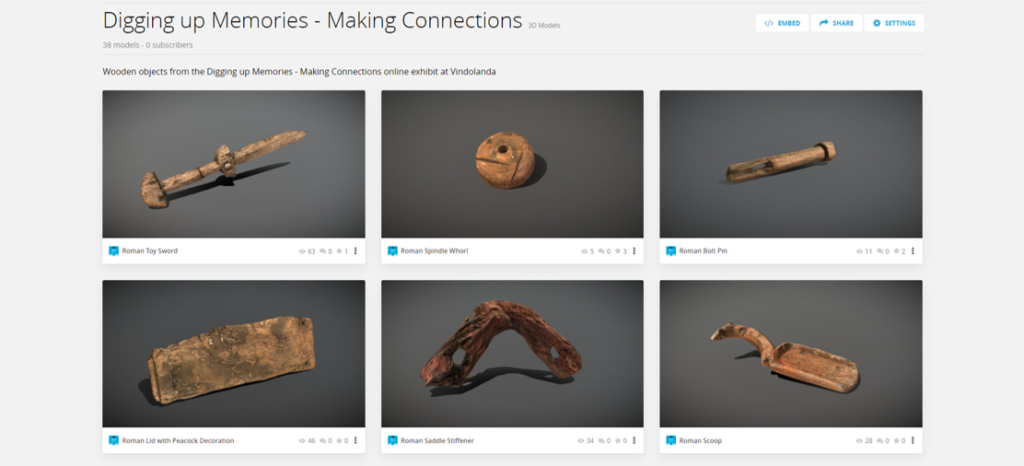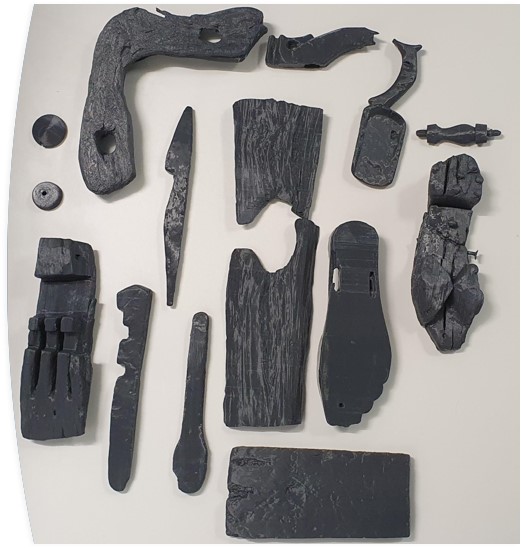This summer, TUBA were hard at work with 3D scanning for the Digging up Memories – Making Connections online exhibit that has now officially gone live! You might even have seen snippets yourself or read about it in the recent Teesside University press release. And so, we thought it’d be nice to give a little behind-the-scenes of this amazing opportunity.
How does 3D scanning actually work? Well, there are lots of different types of 3D scanners, all with their own applications and uses. For this exhibit, we used a structured light scanner (SLS), which works by projecting a tightly calibrated set of patterns onto an object. The pattern changes shape as it falls onto an object, resulting in 3D measurements. This process takes a full, closed scan of the camera view, which we then apply a texture to by applying red, blue and green light filters:
How can we use this in our work with Vindolanda? As you may have noticed in some of our previous blog posts, we’re big fans of 3D here, including animal and human heads on pikes, and the Locomotion. We’ve even published on 3D scanning of ox crania used in target practice, and have some further outputs on their way. The key outcome from 3D scanning for the museum environment is access. How often have you visited a museum and though “hey, that’s a pretty cool object, I wanna look closer”? 3D scanning provides a digital model of the object that you can freely zoom in and out or rotate around, which is.. well, pretty neat! However, we can then run some bespoke processes to make these 3D printable. That’s right – you can properly get hands-on with highly accurate replicas of delicate and fragile museum objects!
So where does this lead us? Well, over the years, we’ve been partaking in several exhibits on the 3D scanning, chemical and microbial work we’ve been undertaking at Vindolanda. Following the success of these, we were invited to Vindolanda over the summer to explore the suitability of 3D scanning a wide range of wooden objects. To say we were excited and proud of this opportunity is an understatement!
There is such a fabulous range of wooden artefacts available for your viewing from the comfort of your sofa, so please do look at these either on Sketchfab or better yet, on the Digging up Memories exhibit on the Vindolanda website! Here, you can find more information, videos and commentary on each object plus the 3D models. Some of these are incredibly rare, such as the only conserved wooden toilet seat in Britain, the cherry wood saddle stiffener, or the wooden trowel with mortar still stuck to it!

We do have a couple personal favourite objects, of course. The wooden toy sword is an excellent artefact because it really demonstrates that the military took their families with them to Vindolanda, rather than the typical focus on conflict and fighting. The pepper pot is also great because of how well the 3D scanning came out – we had anticipated this to be poor because it’s a very cylindrical object that normally doesn’t facilitate 3D scanning but there was just enough of an irregular morphology to stitch together and texture beautifully. Atto’s Workbench is also a fantastic object but the sheer size and lack of thickness meant it took more scans and time than any other object we’ve scanned in order to fully capture and register together. This was well worthwhile because you can actually feel the hammer impressions on the 3D printed version!

And that brings us nicely to our final point – hopefully over the coming days, weeks and months, you’ll have the opportunity to visit Vindolanda and get hands-on with some highly accurate 3D printed versions of a wide selection of these wooden artefacts! We cannot recommend this enough; this evokes such a different set of emotions and leaves an experience that lingers for a long time. Who knew that something as banal as opening and closing a pepper pot lid could be so captivating!
How did all of this come about? Purely thanks to so many people involved, coming together for this collaborative effort, with Vindolanda Trust and Dr Anneke Hackenbroich driving this project forward. Our utmost thanks to them for inviting us to be part of this special exhibit, we’re all thrilled here to see it come together as I’m sure all are at home too!
Lastly, keep an eye out for updates to the Digging up Memories – Making Connections exhibit, with more objects being added at the start of November and December.
TUBA



